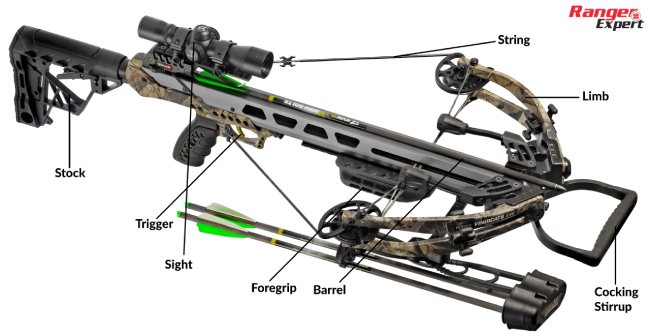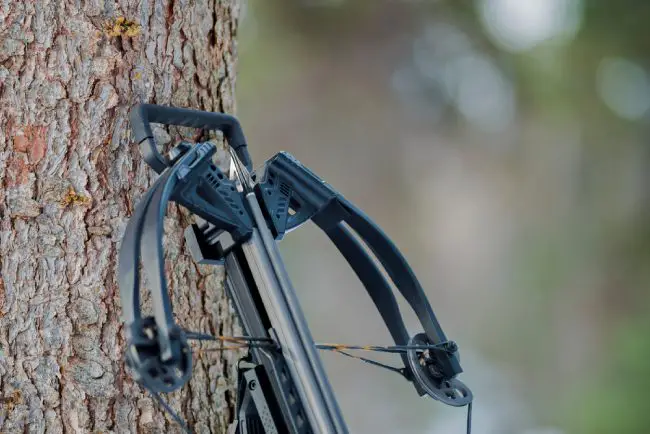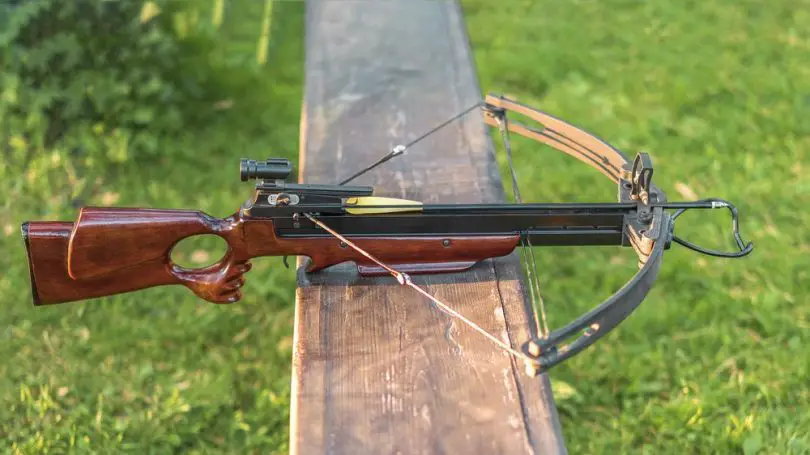Crossbows have been used for a really long time in both war and hunting. Even though guns are more common now, people still use crossbows for fun things like competitions and shooting targets. But how does a crossbow work?
A crossbow works by utilizing a string to shoot bolts. While sounds similar to a bow and arrow, the mechanics of a crossbow differ significantly from those of a traditional bow. Power and accuracy is also more in a crossbow. Plus, they can travel longer and provide greater penetration.
Keep reading to get a comprehensive idea about how a crossbow works.
Anatomy of a Crossbow

A crossbow has four important parts that work together to shoot a projectile. These parts are the bow, the stock, the trigger mechanism, and the string.
The Bow
The bow is what stores the energy when you pull back the bowstring. It is typically made of wood, carbon fiber or fiberglass.
The Stock
The stock supports the bow and trigger mechanism of a crossbow. Wood or synthetic material is typically used to make this. The shooter holds it against his shoulder when shooting.
- Foregrip: The front part of the stock is called the foregrip. It rests against the shoulder of the shooter and absorbs the recoil when you shoot the crossbow.
- Buttstock: The buttstock is the rear part of the stock that rests against the shooter’s shoulder. It is designed to absorb the recoil when the crossbow is fired.
The Trigger
The trigger mechanism on a crossbow allows you to release the bowstring to fire the bolt. Usually, it is positioned at the back of the stock and the user uses his index finger to operate it.
- Trigger: The trigger serves as the pivotal component of the mechanism, which, when engaged by the shooter’s finger, propels the release of the bowstring.
- Latch: The locking mechanism, commonly referred to as the latch, is responsible for securely fastening the bowstring until the moment the trigger is activated.
The String
The string of a crossbow is what propels the projectile forward when it is released. It is made of strong synthetic fibers such as Dacron or Spectra.
- Serving: The serving is a protective layer of material that wraps around the string where it contacts the bow and the trigger mechanism.
How a Crossbow Stores Energy
When you draw back the bowstring of a crossbow, this makes the bow flex and store energy. Now, what amount of energy will be stored depends on several factors, which include the strength and length of the bow as well as the weight of the bolt.
- Draw Weight: The draw weight indicates the amount of force you will need to draw the bowstring back to its fully cocked position. Crossbows draw weight can range from 75 to 300 pounds and even more.
- Draw Length: How far back the bowstring is pulled from its starting position affects how much energy the bow can hold. This distance is called the draw length.
- Power Stroke: The measure of the length that the bowstring traverses from its completely cocked stance to its release point is commonly referred to as the power stroke. This pivotal factor significantly impacts the quantum of energy that a bow can amass.
Upon releasing the bowstring, the potential energy that had been accumulated in the bow is instantaneously transferred to the projectile, propelling it forward with great velocity.
Factors that Affect a Crossbow’s Performance
Several factors can affect the performance of a crossbow, including:
Projectile Weight and Type
A good quality bolt can hinder or increase your performance. The weight, shape, size and type of the bolt can significantly influence the performance of a crossbow. These things also affect its speed, trajectory and accuracy.
- Arrow Weight: While heavier arrows have more penetrating power, they may be slower as well as less accurate than the lighter arrows. And how much kinetic energy will be transferred to the arrow from the bow will depend on the heaviness of the arrow.
- Arrow Material: The selection of arrow material can significantly impact its functional efficiency. Noteworthy options in this regard encompass aluminum, carbon fiber, and wood.
- Broadheads: Broadheads serve as the arrow tips employed in hunting, and their diverse shapes and sizes can significantly impact the precision and depth of arrow penetration.
Draw Weight and Length
As previously alluded to, the draw weight and length of a crossbow are critical factors that influence the potential energy stored within the bow. Typically, crossbows exhibiting higher draw weights and longer power strokes manifest superior power and velocity compared to their counterparts with lower draw weights and shorter power strokes.
Bow Design
The design of the bow is also a notable performance influencing factor. The amount of energy stored in the bow can be affected by the length, width and shape of the limbs. This also impacts the accuracy and speed of the bolt.
Trigger Mechanism
The trigger mechanism is another critical component that can affect a crossbow’s performance. The quality and design of the trigger can affect the trigger pull weight, the smoothness of the trigger, and the accuracy of the shot.
Using a Crossbow Safely and Effectively
Now that you understand how a crossbow works and the factors that affect its performance, it’s essential to know how to use one safely and effectively.
- Always Point in a Safe Direction: When handling a loaded crossbow, always point it in a safe direction. Never point it at anyone, including yourself.
- Keep Fingers and Hands Away from the String: The string of a crossbow can cause serious injury if it snaps back and hits your fingers or hands. Always keep your fingers and hands away from the string and trigger mechanism.
- Use the Correct Arrow: Always use arrows that are recommended for your crossbow. Using the wrong type of arrow can cause damage to the bow or result in inaccurate shots.
- Check the Crossbow Before Each Use: Before using your crossbow, check it for any damage or wear and tear. Make sure the string is in good condition, and the trigger mechanism is functioning correctly.
- Practice Proper Shooting Form: Proper shooting form can help improve accuracy and prevent injuries. Always hold the crossbow with both hands, and use the foregrip to steady the bow.
How Does A Compound Crossbow Work

When you first think about how does a crossbow work, it doesn’t seem like there is much work going on. You load the arrow, the string is kept tensed by the trigger and the string releases when you click the trigger. While its functionality resembles the working of a bow, the execution is not the same.
You might have noticed double strings and four cams on many of the compound bows. This is unlike the traditional compound bows that typically have one bowstring and two limbs.
Now, send the string through the cams. By doing this, you are increasing the string tension a lot. And due to this, more kinetic energy will be generated, which will result in powerful shots and higher speed.
That is why premium crossbows are equipped with multiple bowstrings and 4 cams. It enables you to have a great shooting experience by increasing the string tension.
How Does A Modern Crossbow Work?
All crossbows in the market are modern crossbows. From compound crossbow, recurve crossbow, and repeating crossbow, the first two are more popular than the last one.
Recurve crossbow also comes equipped with multiple cams like the compound crossbow. However, the difference is that the recurve crossbow is noisy and needs more drawing force. If you want to get a good crossbow for hunting, recurve crossbows might not be the best crossbow choice for you. On the off chance that you get one or already have one, you can use noise dampeners for your crossbow.
Shooting a recurve crossbow is also not so hard. You load the arrow and pull the wire to cock the crossbow, tensing up the bowstring. Now, when you press the trigger to release the bowstring, all the kinetic energy will be delivered to the arrow and the arrow will be shot.
How Does A Pistol Crossbow Work?
Due to the similarities with the pistol, this crossbow is called the pistol crossbow. This handheld weapon can be used with one hand.
It is like the small version of a crossbow. It has the same mechanism and functionality as the regular size crossbow. You place an arrow in the flight track and then pull the bowstring. There’s no cocking device required; actually you can’t use one. You can load the crossbow using your hand as not much power is required and they are also not heavy.
This also means if you are looking for something powerful, they shouldn’t be your choice. However, you can use them as backup. Since they are small, they will be easy to carry and you can utilize them once you come in close contact with your target.
How Does A Repeating Crossbow Work
It takes time to load a crossbow and if the draw-weight is higher, it will take more time to reload it. But there is a method to get around this issue and the name of that method is repeating crossbow.
As you may have guessed from the name, repeating crossbows can fire more than a single bolt in each shot using a mechanism.
So, how does a repeating crossbow work?
You still stack the arrow the same way. And modern repeating crossbows are equipped with a spring-loaded pressure plate that pushes down the arrows so that you don’t have to use your hand. The crossbow has the repeating lever underneath it instead of the top.
Inside the chamber, there is the bowstring. After firing one bolt, you don’t have to use your foot to load the other one. Just pulling the repeating lever will allow you to take another shot after each shot. The bolts will be loaded automatically from the chamber and ready for firing.
Sounds simple, right? However, people still choose compound crossbows over repeating crossbows because they are not the most effective option and not as powerful as compound or recurve crossbows.
How Does A Crossbow Trigger Work?
Modern crossbow triggers typically look like pistol triggers. The trigger holds the bowstring after you load the bolt.
And once you pull the trigger, the bowstring is let go by the limb inside the trigger chamber. That’s when the bowstring pushes the bolt with high kinetic energy. That’s generally how does a crossbow trigger work.
Conclusion
In conclusion, a crossbow is a powerful and versatile weapon that has been used for centuries. Understanding how it works and the factors that affect its performance is essential for anyone interested in using one safely and effectively. By following the guidelines and safety tips outlined in this article, you can enjoy the sport of crossbow shooting while minimizing the risk of injury.
FAQs
How does a crossbow store and release energy?
A crossbow stores energy by bending the limbs of the bow when the string is pulled back. This creates elastic potential energy in the bow. When the trigger is pressed, the string is released and the energy is transferred to the bolt, which flies out of the crossbow at high speed and allows the crossbow to shoot far.
How does a crossbow hold the arrow in place?
The arrow retention spring allows the crossbow to hold the arrow in place. This small piece presses down on the arrow to keep it aligned with the string. The arrow retention spring also holds back the trigger to help you cock the crossbow.
Is it hard to shoot a crossbow?
Shooting a crossbow is easy. You just target and pull the trigger, that’s it. The other things involved with crossbow shooting are not so easy.
Crossbows are heavier, so they are not easy to transport or walk with. Plus, you need to cock them with an arrow before you can shoot. And since you need to use them from close range, it takes a higher degree of effort to get into position while hunting.
Can you dry fire a crossbow?
You can, but you never should. Dry fire is shooting the crossbow without an arrow, which you should never do as this can cause damage to the crossbow and might even injure you.
Can you leave your crossbow cocked?
Do not leave your crossbow cocked. And never do it for longer than 24 hours. This can cause the string and cable to stretch prematurely and decrease the performance of the crossbow. Also, reduce the lifespan of the string.
Do crossbows use regular arrows?
No, you can not use regular arrows with crossbows. They are not interchangeable. Compared to regular arrows, crossbow arrows are shorter and usually range from 18″ to 22″ long.









Leave a Comment